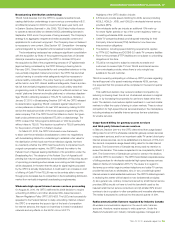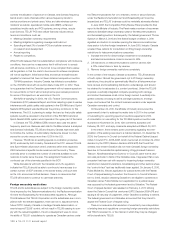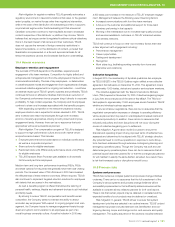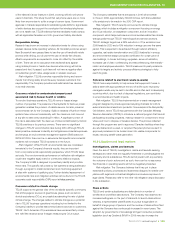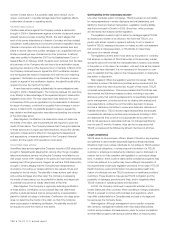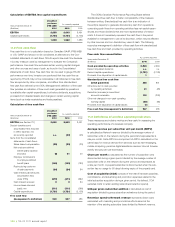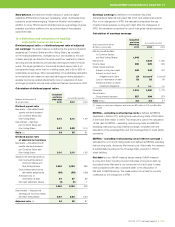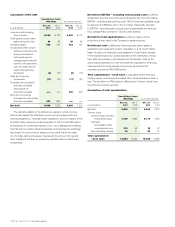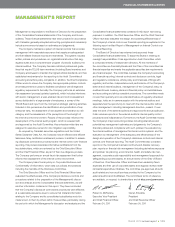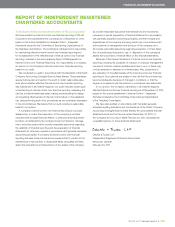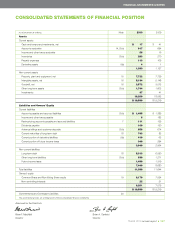Telus 2010 Annual Report Download - page 112
Download and view the complete annual report
Please find page 112 of the 2010 Telus annual report below. You can navigate through the pages in the report by either clicking on the pages listed below, or by using the keyword search tool below to find specific information within the annual report.108 . TELUS 2010 annual report
January 2011 Monetary Report estimated growth of 2.4% for 2011
and 2.8% for 2012. Persistent strength in the Canadian dollar continues
to act as a drag on the Canadian economy. In addition, Statistics
Canada’s December 2010 Labour Force Survey reported an unemploy-
ment rate of 7.6%, down from 8.5% in December 2009. Improvement
in employment levels may continue to lag the economic recovery.
With recent strength in the Canadian natural resource sector and
growth in Asia, growth in Alberta and British Columbia is expected
to be stronger than in Central Canada. However, some concerns remain
around unemployment rates, the timing and impact of reduced govern-
ment spending, the impact of increases in interest rates currently expected
from the Bank of Canada later in 2011, and the impact of U.S. and
global economic weaknesses.
Slow or uneven economic growth may adversely impact TELUS
Economic uncertainty may cause residential and business telecommu-
nications customers to delay new service purchases, reduce volumes
of use, discontinue use of services or seek lower-priced alternatives.
A significant economic downturn or recession could adversely impact
TELUS’ profitability, free cash flow and bad debt expense, and potentially
require the Company to record impairments to the carrying value of
its assets including, but not limited to, its intangible assets with indefinite
lives (spectrum licences) and its goodwill. Impairments to the carrying
value of assets would result in a charge to earnings and a reduction
in owners’ equity, but would not affect cash flow.
Risk mitigation: The Company cannot completely mitigate economic
risks. TELUS continues to focus on five key diversified vertical business
markets: the public sector, healthcare, financial services, energy and
telecom wholesale. The public sector, healthcare and financial services
vertical markets are generally expected to be less exposed to economic
cycles. TELUS continues to pursue cost reduction and efficiency initia-
tives. The Company expects its 2011 capital expenditures to be at a level
similar to 2010 and approximately 19% lower than in 2009. If necessary,
the Company could consider additional cost and efficiency initiatives
and lower capital expenditure levels in future years.
Pension funding
Economic and capital market fluctuations could also adversely impact
the funding and expense associated with the defined benefit pension
plans that TELUS sponsors. There can be no assurance that TELUS’
pension expense and funding of its defined benefit pension plans will
not increase in the future and thereby negatively impact earnings and/
or cash flow. Defined benefit funding risks may occur if total pension
liabilities exceed the total value of the respective trust funds. Unfunded
differences may arise from lower than expected investment returns,
reductions in the discount rate used to value pension liabilities, and
actuarial loss experiences.
Risk mitigation: TELUS seeks to mitigate this risk through the appli-
cation of policies and procedures designed to control investment risk and
ongoing monitoring of its funding position. Pension expense and funding
for 2011 have been largely determined by the rates of return on the plans’
assets for 2010 and interest rates at year-end 2010. Under IFRS, TELUS’
actuarial gains and losses for defined benefit plans are charged to Other
comprehensive income, partly contributing to an estimated pension
recovery of approximately $34 million in 2011, as compared to a pension
expense of $28 million in 2010 as currently reported under Canadian
GAAP. The Company’s best estimate of cash contributions to its defined
benefit pension plans in 2011, including a $200 million voluntary special
contribution in January 2011, is $298 million ($137 million in 2010).
Risk mitigation: TELUS has an extensive ongoing enterprise-wide
business continuity program (BCP) with resources dedicated to design,
exercise, maintain, execute and monitor business continuity/disaster
recovery policies, plans and processes that address a range of scenarios
and for its key facilities. This approach is focused on supporting TELUS’
continued ability to serve customers and protect corporate assets, and
strives to ensure employee protection and safety by instituting resiliency
planning in the Company’s day-to-day business operations. In regard to
internationally situated business support and outsourcing functions, TELUS
has acquired and/or announced expansion of these activities in additional
countries in different geographic regions to mitigate the risk of locating
these functions in one country. TELUS has had a pandemic plan in place
for more than five years. In 2010, pandemic plans were audited, exercised
and updated to address the threat and to accommodate key lessons
from the 2009 H1N1 influenza outbreak. TELUS continues to monitor the
pandemic threat and maintain plans to address it. In addition, TELUS
continues to sustain ongoing risk mitigation in regards to seismic
upgrades, fire protection, flood prevention and power provisioning.
Although TELUS has business continuity planning processes in
place, there can be no assurance that specific events or a combination
of events will not materially impact TELUS operations and results.
Security – Electronic attack
Electronic attacks are intentional acts to gain unauthorized access
to TELUS information or to prevent legitimate users from gaining access.
Such attacks may use a range of techniques, from social engineering
(non-technical intrusion relying heavily on human interaction and trickery
to break normal security procedures) to the use of sophisticated
software/hardware.
Risk mitigation: Using a layered security approach, TELUS has
implemented a number of proactive, reactive and containment processes
and systems to safeguard its IT infrastructure, information repositories
and information distribution. Security policies and procedures are in place
to govern the duties of those responsible for information confidentiality
and integrity. Intrusion detection systems, access controls and incident
response procedures are in place to provide continuous monitoring
of TELUS’ IT infrastructure.
Security – Vandalism and theft
TELUS has a number of publicly situated physical assets that are subject
to vandalism and/or theft, including public payphones, copper cable,
and network and telephone switch centres.
Risk mitigation: The Company has implemented an array of physical
and electronic barriers, controls and monitoring systems to protect
its assets, considering such factors as asset importance, exposure risks
and potential costs incurred should a particular asset be damaged or
stolen. As an additional level of risk management, TELUS has a corporate
security group that continually investigates and evaluates the risks and,
in co-operation with law enforcement and other external agencies,
adjusts its level of protection to meet changing risks.
While TELUS has IT and network security planning processes,
and thorough physical asset security planning processes, there can
be no assurance that specific events will not materially impact TELUS
operations and results.
10.11 Economic growth and fluctuations
Economic growth in Canada was estimated to be 2.9% in 2010, supported
by monetary and fiscal stimulus, after the economy emerged from a
year-long recession in the third quarter of 2009. The Bank of Canada’s



